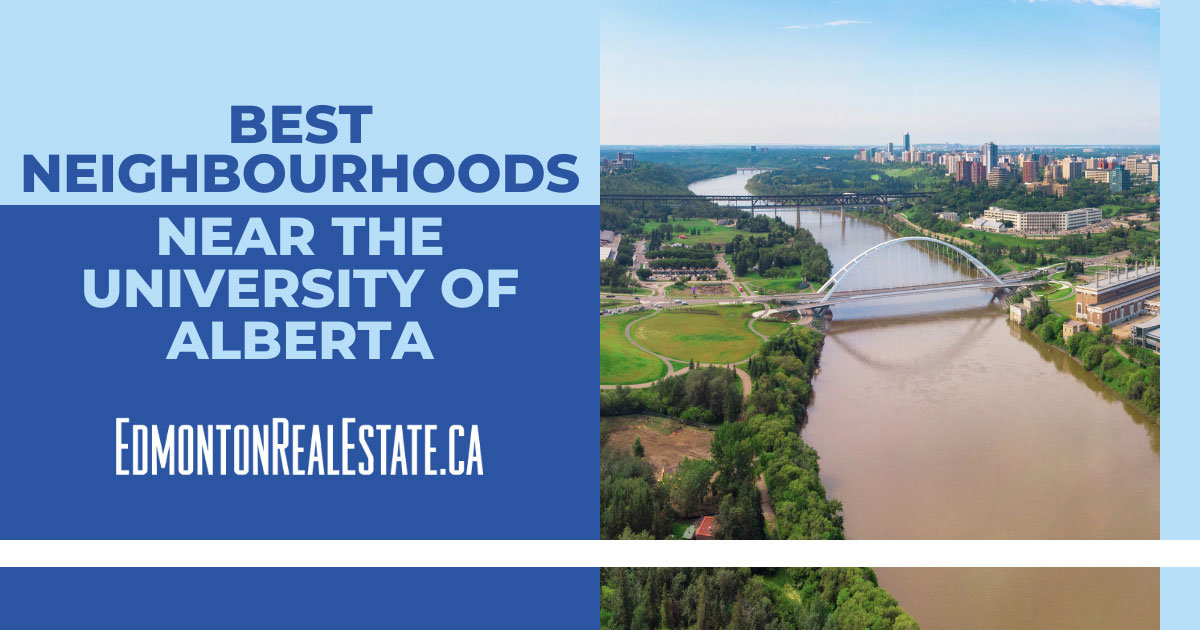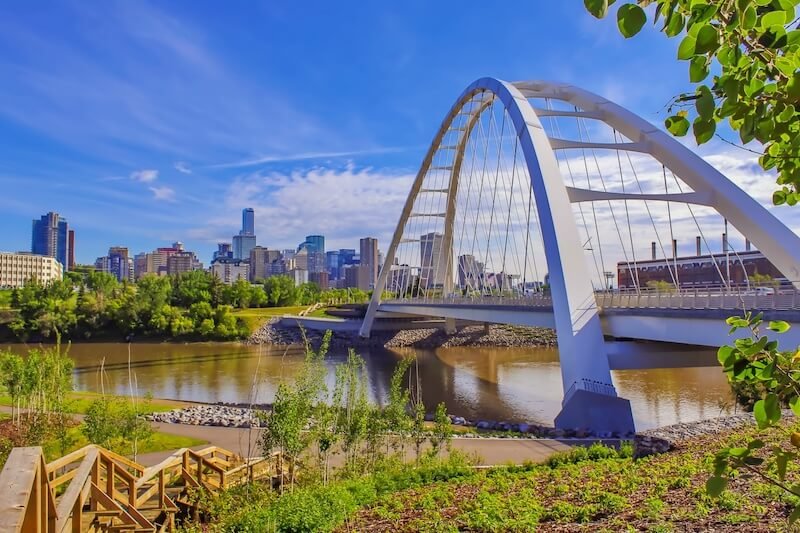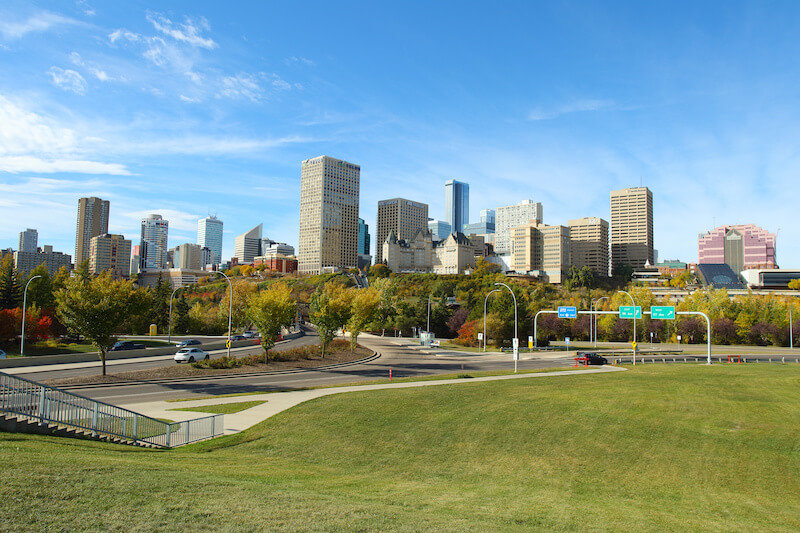8 Best Neighbourhoods Near University of Alberta in Edmonton, AB
Posted by EdmontonRealEstate .ca on Thursday, November 2nd, 2023 at 10:07am.

If you're looking for the best places to live near the University of Alberta, you can choose among some of Edmonton’s best neighbourhoods, each offering a unique capital city living experience. This university is a major part of the city of Edmonton, and the areas around it offer a variety of living experiences. Whether you're a student, faculty member, or just someone looking to live close to this educational hub, understanding the local communities is key. Explore the unique characteristics, amenities, and atmosphere of each neighbourhood to find your perfect spot near the University of Alberta.
Garneau
Garneau is one of Edmonton's most walkable neighbourhoods, featuring a charming Bohemian vibe, housing options overlooking the river valley, and fun local attractions.
The neighbourhood's namesake is Laurence Garneau, a former Hudson's Bay Company employee who settled in the area around 1874. Garneau experienced some development as part of the City of Strathcona but did not fully develop until after amalgamation with Edmonton in 1912. As the nearby University of Alberta expanded, apartments replaced many of Garneau's original homes.
Most homes in Garneau were built in the 1960s and 70s, but the neighbourhood saw some additional construction between 2001 and 2006. Today, Garneau offers an eclectic collection of pre-war homes, post-modernist tower blocks, and new contemporary construction.
Garneau has numerous condo communities, with units featuring up to three beds and baths selling for $115,000 to $650,000. Meanwhile, single-household homes with three to five bedrooms and two to four bathrooms can cost $475,000 to $1.2 million.
Located just east of the University of Alberta Hospital, Garneau is a three-minute walk or one-minute bike ride from the university's main campus. The neighbourhood also hosts attractions like the historic Garneau Theatre and The Hexagon Board Game Cafe.
Garneau Amenities
- Four parks
- Three playgrounds
- Hiking/biking trails
- 20 bus stops
- Streetcar
- Garneau School
- City Arts Centre
- Community league
Queen Alexandra
Queen Alexandra is one of the city’s leading cultural centres, boasting some of the most scenic views and architecture in Southwest Edmonton.
The neighbourhood was named in honour of Queen Alexandra, wife of King Edward VII of England. The northern part of Queen Alexandra borders Whyte Avenue and was originally part of the Town of Strathcona but joined Edmonton during the amalgamation.
Queen Alexandra saw rapid development north of University Avenue before World War I, while most development south of the thoroughfare occurred in the 1940s and later. While higher-density housing replaced many of the neighbourhood's original single-household homes, construction slowed to a near standstill in the 1980s.
Most Queen Alexandra homes are one- or two-bedroom condos priced from $100,000 to $320,000. Many feature balconies and excellent city, ravine, and river valley views. Buyers can also find detached homes and half-duplexes with up to seven bedrooms and four bathrooms for $370,000 to $990,000.
A 2014 neighbourhood renewal program added dedicated bike lanes and raised sidewalks, making Queen Alexandra more navigable. The University of Alberta main campus is a four-minute drive, seven-minute bike ride, or twenty-two-minute walk from the neighbourhood.
Residents will find most essentials at the Old Strathcona Shopping Centre, which has a grocery store, a medical centre, and restaurants like Rosie's Bar & Grill and Dream Tea House.
Queen Alexandra Amenities
- Three schools
- Five parks
- Two arenas
- Scona Pool
- 26 bus stops
- St. Basil's Cultural Centre
- Community league
Strathcona

Once Edmonton's rival city, Strathcona maintains a distinct identity today, with a highly walkable commercial district and a charming mix of historic homes and newer Edmonton condos.
Strathcona's development began when the Calgary and Edmonton Railway line arrived in 1891. The community was incorporated as a town just eight years later and then as a city in 1907. Its moniker came from Lord Strathcona, who served as HBC's Governor from 1889 to 1914.
While Strathcona initially competed with Edmonton, the cities amalgamated in 1912. As Edmonton's commercial development overtook Strathcona's, many of the neighbourhood's older buildings were spared redevelopment. Most of the earliest homes employed wood-frame construction techniques, but a 1902 law mandating non-wood construction to prevent fires caused brick homes to dominate Strathcona.
Detached homes in Strathcona list from $365,000 to $1.1 million for two to seven bedrooms and up to four bathrooms. However, condos comprise the bulk of housing options, ranging from $90,000 for one bed and bath to $4 million for a swanky penthouse.
Commercial development in Strathcona has always centred on Whyte Avenue, which runs through the heart of Old Strathcona and features numerous pubs, cafés, and restaurants. The area hosts the Old Strathcona Farmers' Market, the Old Strathcona Antique Mall, and the annual Edmonton International Fringe Festival.
With several major traffic routes in Strathcona, residents can easily reach the university's main campus in five minutes by car, seven by bike, or twenty on foot.
Strathcona Amenities
- 10 parks
- Three schools
- Two theatres
- 31 bus stops
- Public library
- John Walter Museum
- Edmonton Radial Railway Society
- Community league
Ritchie
Moving on to Southeast Edmonton, Ritchie is a walkable neighbourhood boasting a wide variety of housing options near countless shops and restaurants.
The neighbourhood's name honours Robert Ritchie, former Strathcona mayor and original owner of the historic Ritchie Mill, Alberta's oldest surviving flour mill. Development began with the completion of the Calgary and Edmonton Railroad and Edmonton, Yukon, and Pacific Rail lines around the turn of the century. By the time Ritchie joined Edmonton in 1912, the neighbourhood had already been subdivided, primarily using a grid plan.
Like other former Strathcona neighbourhoods, Ritchie's development stemmed from Whyte Avenue, the community's northern border. Today, Ritchie Market is the neighbourhood's commercial hub, featuring a brewery, bakery, butchery, and award-winning restaurant, Biera. The nearby Blue Chair Café offers brunch and live music. Residents can also head over to Old Strathcona for even more nightlife options. The university's main campus is just seven minutes away by car or thirteen by bike.
Just under half of all homes in Ritchie are single-household, with semi-detached dwellings and condos making up the remainder. Single-household homes typically offer two to six bedrooms and up to four bathrooms for $300,000 to $1.3 million. Meanwhile, one- and two-bedroom condos can cost $145,000 to $400,000.
Ritchie Amenities
- Two schools
- Two playgrounds
- Outdoor rink
- 29 bus stops
- Hiking/biking trails
- Mill Creek Ravine
- World Arts Organization
- Community league
Belgravia
Belgravia is a relatively remote and highly sought-after neighbourhood, boasting some of the largest lots and a share of the luxury homes in Edmonton.
Belgravia began development after Robert Tegler put the area on the market in 1912. About four-fifths of the neighbourhood was built between 1946 and 1960. The community's name comes from a fashionable residential section of 19th-century London.
With just 895 homes in the neighbourhood, Belgravia has always been one of the city's most prestigious communities. Homes on Saskatchewan Drive are especially desirable due to their impressive river valley views. Single-household homes, mostly low-density bungalows, semi-bungalows, and two-storey homes, account for 72% of the neighbourhood. Homes in Belgravia list from $630,000 to $1.2 million for three to seven bedrooms and two to four baths. Belgravia also has four condo communities. Suites with up to three beds and baths can cost $300,000 to $775,000.
While Belgravia is predominantly residential, the neighbourhood has several restaurants, including Belgravia Hub and Mood Cafe. Residents can find even more attractions in the nearby downtown.
Nestled between the University of Alberta's main and south campuses, Belgravia is just four to six minutes from either campus by car, about five minutes by bike, and less than twenty minutes on foot.
Belgravia Amenities
- Belgravia Park
- Hiking/biking trails
- Skating rink
- 12 bus stops
- LRT station
- Belgravia School
- Whitemud Equine Learning Centre Association
- Community league
Downtown Edmonton

Downtown Edmonton is a highly walkable, centrally located neighbourhood with a thriving arts and entertainment scene, year-round festivals, and over 40 condo communities. Most of Edmonton’s best condo communities are located here, and homes in Downtown Edmonton—which are exclusively condos—typically list between $55,000 and $3.3 million, based on the size, views, and amenities.
Fort Edmonton, which once occupied the current site of the legislature grounds west of downtown, strongly influenced the area's development. With HBC Reserve lands directly north of the Fort, the town expanded to the east, developing a commercial hub on Jasper Avenue and 97th Street. While Jasper Avenue remains the city's main street, commercial development has significantly expanded.
The 25-acre ICE District centred on Rogers Place is one of the neighbourhood's newest additions. It is Canada's largest mixed-use sports and entertainment district, featuring premium office space, high-end residences, a luxury hotel, boutique shops, and restaurants.
Meanwhile, the Arts District has attractions like The Citadel Theatre, the Francis Winspear Centre for Music, and Churchill Square, which hosts most of the city's festivals.
Downtown is home to Edmonton’s tallest high-rises, and the area enjoys less congestion than other Canadian city centres. There’s also quick and reliable transit access, allowing residents to reach the university's main campus in four minutes by car, eight minutes via public transit, or nine minutes on a bike.
Downtown Edmonton Amenities
- Six parks
- Public library
- Edmonton Pedway
- 92 bus stops
- Five LRT stations
- Royal Alberta Museum
- Edmonton City Centre
- Community league
Parkallen
Parkallen is a serene older neighbourhood featuring post-war homes along narrow, tree-lined streets. Developed primarily after World War II, Parkallen's layout is typical of Edmonton neighbourhoods from this period, featuring a modified grid pattern centred on a park and one of the primary schools in Edmonton, Parkallen School. Once known as Beau Park and Bridgeland, the neighbourhood's residents chose to call the community Parkallen in 1945.
About 65% of the homes in Parkallen are single-household, especially bungalows and semi-bungalows, with three to five bedrooms and two to four bathrooms. About 20% are two-bed, two-bath condos in low-rises. While single-household homes can range from $345,000 to $960,000, condos are typically just $330,000 to $385,000.
Parkallen is a quiet neighbourhood with no through traffic, but three major arterials serve as boundaries for the community, which makes driving in Edmonton convenient for residents. Just 2.5 kilometres away, Southgate Centre offers over 180 high-end shops. Residents can also find restaurants like Rick & Alice's Grill and Annie Rue Ice Cream within Parkallen.
Parkallen residents can reach either university campus in about five minutes by car, less than ten minutes by bike, and under thirty minutes on foot.
Parkallen Amenities
- Two parks
- 10 bus stops
- Parkallen School
- Alberta School for the Deaf
- St. Basil's Cultural Centre
- Community league
McKernan
McKernan offers many housing options between the University of Alberta's main and south campuses. McKernan residents can generally reach the university in less than five minutes, while the south campus is less than ten minutes away by car, bike, or via Edmonton’s public transit system.
The neighbourhood was named after James McKernan, who lived on the land before it was developed. Although plans were made for McKernan's subdivision after it joined Edmonton in 1912, economic woes delayed development until the 1940s. McKernan's original farmhouse was demolished in 1940, and former tourist attraction McKernan Lake was drained to make way for the neighbourhood's construction.
Most low-density housing in McKernan is from between 1947 and 1953. About 45% of the homes in McKernan are single-household homes, while 46% are semi-detached. Single-household homes and duplexes in McKernan can cost $465,000 to over $1.1 million. Townhomes, priced around $360,000, and condos, priced around $200,000, were also added in the 1950s through 1970s.
McKernan is almost exclusively residential, but Coriander Cuisine and Campus Pizza provide some local dining options.
McKernan Amenities
- Three parks
- Skating rink
- McKernan School
- LRT Station
- 15 bus stops
- Community league
Edmonton’s University of Alberta-Area Communities
Exploring neighbourhoods near the University of Alberta in Edmonton reveals a range of options, each with its unique appeal. From vibrant communities brimming with local businesses and Edmonton’s best parks to quieter areas, there's something for everyone. Finding the right fit near the University of Alberta enhances your living experience, making it well worth the effort to delve into what these Edmonton communities have to offer. So, explore, compare, and discover the neighbourhood that feels just right for you.
If you're looking for the perfect Edmonton home, contact EdmontonRealEstate.ca in partnership with Justin Havre at (780) 800-9644 to get in touch with a local Edmonton real estate agent and discover your new dream home today.

